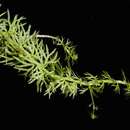en
names in breadcrumbs


Planhigyn cigysol, blodeuol yw Chwysigenddail Llychlyn sy'n enw lluosog. Mae'n perthyn i'r teulu Lentibulariaceae. Yr enw gwyddonol (Lladin) yw Utricularia stygia a'r enw Saesneg yw Nordic bladderwort.[1] Ceir enwau Cymraeg eraill ar y planhigyn hwn gan gynnwys Swigenddail Llychlynaidd.
Mae'r planhigyn hwn yn byw mewn gwlyptiroedd, rhostir, glannau llynnoedd a mannau tebyg. Gall ddal a threulio pryfaid bychan yn ei dentaclau gludiog. Cant eu dennu yno gan arogl siwgwr a gaiff ei greu mewn chwarennau pwrpasol. Mae ganddo flodau bychan pinc. Tyf i uchder o 3–16 cm ac mae ganddo flodau pinc, weithiau rhai gwyn sydd oddeutu 15 mm, o siap twmffat.
Planhigyn cigysol, blodeuol yw Chwysigenddail Llychlyn sy'n enw lluosog. Mae'n perthyn i'r teulu Lentibulariaceae. Yr enw gwyddonol (Lladin) yw Utricularia stygia a'r enw Saesneg yw Nordic bladderwort. Ceir enwau Cymraeg eraill ar y planhigyn hwn gan gynnwys Swigenddail Llychlynaidd.
Mae'r planhigyn hwn yn byw mewn gwlyptiroedd, rhostir, glannau llynnoedd a mannau tebyg. Gall ddal a threulio pryfaid bychan yn ei dentaclau gludiog. Cant eu dennu yno gan arogl siwgwr a gaiff ei greu mewn chwarennau pwrpasol. Mae ganddo flodau bychan pinc. Tyf i uchder o 3–16 cm ac mae ganddo flodau pinc, weithiau rhai gwyn sydd oddeutu 15 mm, o siap twmffat.
Der Dunkelgelbe Wasserschlauch (Utricularia stygia) oder Dunkle Wasserschlauch ist eine Pflanzenart aus der Gattung der Wasserschläuche (Utricularia).
Der Dunkelgelbe Wasserschlauch ist eine sommergrüne, wurzellose, untergetauchte Wasserpflanze, die Wuchshöhen von 5 bis 15 Zentimeter erreicht. Die Endzipfel der Wasserblätter weisen am Rand je (2) 3 bis 6 (7) Wimperzähnchen auf. Die gelbe Krone ist leicht rötlich überlaufen. Die Unterlippe misst 9 bis 11 × 13 bis 15 Millimeter. Der Sporn hat eine Länge von 4 bis 5 Millimeter.
Die Blütezeit reicht von Juli bis August.
Der Dunkelgelbe Wasserschlauch wächst in Deutschland in oligo- bis mesotrophen Gewässern wie Gräben, Tümpeln, Schlenken und flachen Uferbereichen von Seen. Die Art kommt selten in Bayern, Baden-Württemberg (Schwarzwald, Alpenvorland), Rheinland-Pfalz, Nordrhein-Westfalen und Nordost-Sachsen vor. In Schleswig-Holstein gilt sie als ausgestorben. Das Verbreitungsgebiet dieser Art ist nur ungenügend bekannt. Nach P. Uotila (2013) kommt die Art in Europa in Norwegen, Schweden, Finnland, Russland, Großbritannien, Dänemark, Deutschland, Italien, Österreich und Tschechien vor.[1]
Der Dunkelgelbe Wasserschlauch (Utricularia stygia) oder Dunkle Wasserschlauch ist eine Pflanzenart aus der Gattung der Wasserschläuche (Utricularia).
Utricularia stygia, the arctic bladderwort[1] or Northern bladderwort,[2] is an affixed aquatic carnivorous plant that belongs to the genus Utricularia. U. stygia is native to northern Europe and North America. This species was originally published by Göran Thor in 1987 but the description was not in Latin and was therefore nomenclaturally invalid. Thor validly published the species a year later. The cited difference that separates U. stygia from U. ochroleuca is the shape of the tiny quadrifid glands inside the bladders, specifically at which angle the "arms" of these glands diverge from one another. Thor, when working on the Utricularia of Sweden noted that this distinction alone allowed for consistent species identification. Both Barry Rice and Peter Taylor have expressed concerns regarding how this method applies to other populations around the world.[3][4]
Utricularia stygia, the arctic bladderwort or Northern bladderwort, is an affixed aquatic carnivorous plant that belongs to the genus Utricularia. U. stygia is native to northern Europe and North America. This species was originally published by Göran Thor in 1987 but the description was not in Latin and was therefore nomenclaturally invalid. Thor validly published the species a year later. The cited difference that separates U. stygia from U. ochroleuca is the shape of the tiny quadrifid glands inside the bladders, specifically at which angle the "arms" of these glands diverge from one another. Thor, when working on the Utricularia of Sweden noted that this distinction alone allowed for consistent species identification. Both Barry Rice and Peter Taylor have expressed concerns regarding how this method applies to other populations around the world.
Ćěmny pucherjak (Utricularia stygia) je rostlina ze swójby pucherjakowych rostlinow (Lentibulariaceae).
Ćěmny pucherjak (Utricularia stygia) je rostlina ze swójby pucherjakowych rostlinow (Lentibulariaceae).